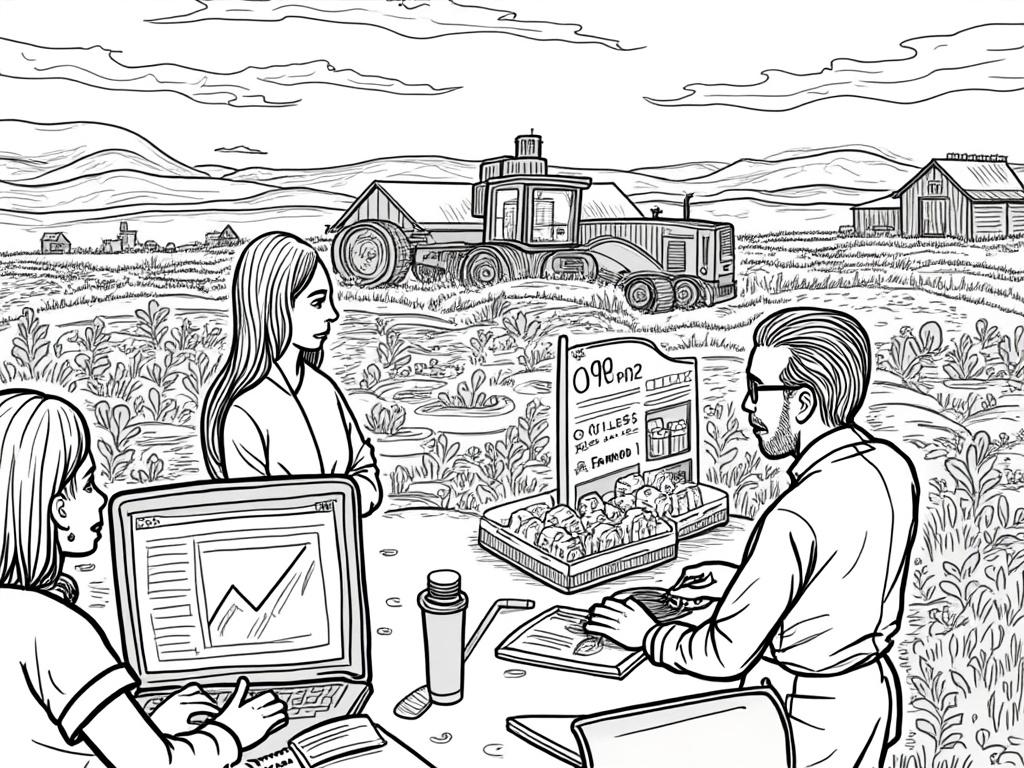
Greece Agricultural Land Percentage: Farming Industry Overview 2025
Reading time: 8 minutes
Ever wondered why Greek olive oil tastes so distinct, or how this Mediterranean nation feeds both its population and exports to global markets despite its mountainous terrain? You’re about to discover the fascinating reality of Greek agriculture—a sector that’s quietly transforming while honoring ancient traditions.
Table of Contents
- Agricultural Land Overview: The Numbers Behind Greek Farming
- Strategic Land Use Patterns and Regional Distribution
- Industry Transformation: From Traditional to Modern Agriculture
- Economic Impact and Export Performance
- Navigating Challenges and Emerging Opportunities
- Harvesting Tomorrow: Strategic Directions for 2025
- Frequently Asked Questions
Agricultural Land Overview: The Numbers Behind Greek Farming
Here’s the straight talk: Greece dedicates approximately 47.1% of its total land area to agriculture—that’s roughly 6.2 million hectares out of 13.2 million total hectares. But here’s what makes this statistic truly compelling: Greece achieves remarkable agricultural productivity despite having some of the most challenging topography in Europe.
Breaking Down the Agricultural Landscape
The Greek agricultural sector operates under unique constraints that would challenge any farming nation. With over 80% of the country classified as mountainous or semi-mountainous, Greek farmers have mastered the art of maximizing limited arable land.
| Land Type | Area (Million Hectares) | Percentage of Total | Primary Use |
|---|---|---|---|
| Arable Land | 2.9 | 22.0% | Cereals, Cotton, Tobacco |
| Permanent Crops | 1.1 | 8.3% | Olives, Grapes, Citrus |
| Pastures & Grazing | 2.2 | 16.8% | Livestock, Dairy |
| Forest & Woodland | 3.9 | 29.5% | Forestry, Conservation |
| Other Land Uses | 3.1 | 23.4% | Urban, Infrastructure |
Regional Distribution: Where Agriculture Thrives
Quick scenario: Imagine you’re planning agricultural investments in Greece. Where would you focus? The answer lies in understanding regional strengths. Thessaly leads with 85% agricultural land use, followed by Central Macedonia at 78%, while mountainous regions like Epirus maintain 35% agricultural coverage despite challenging terrain.
This distribution reflects centuries of adaptation. As Professor Dimitris Psaltopoulos from the University of Patras notes: “Greek agriculture represents one of Europe’s most resilient farming systems, where traditional knowledge meets modern efficiency on limited but highly productive land.”
Strategic Land Use Patterns and Regional Distribution
Understanding Greece’s agricultural success requires examining how farmers maximize every hectare. The country’s average farm size of 6.7 hectares might seem small by international standards, but this creates unexpected advantages in specialty crop production and quality control.
The Mediterranean Advantage: Climate-Driven Specialization
Greece’s Mediterranean climate isn’t just pleasant for tourists—it’s an agricultural goldmine. With 300+ sunny days annually and distinct wet/dry seasons, Greek farmers have developed sophisticated irrigation and crop rotation systems that other Mediterranean nations are now studying and adopting.
Agricultural Productivity by Region (2024 Data)
85% agricultural coverage
78% agricultural coverage
62% agricultural coverage
45% agricultural coverage
35% agricultural coverage
Intensive vs. Extensive Farming: The Greek Balance
Here’s where Greek agriculture gets fascinating: the country has mastered both intensive cultivation of high-value crops (olives, grapes, herbs) and extensive grain production on available plains. This dual approach maximizes both economic returns and food security—a strategy that’s particularly relevant as global food systems face increasing pressure.
Industry Transformation: From Traditional to Modern Agriculture
Well, here’s the transformation story that’s reshaping Greek agriculture: Traditional farming methods are evolving rapidly, driven by EU agricultural policies, climate change adaptation, and digital technology adoption.
Case Study: Olive Oil Revolution in Kalamata
Consider the Kalamata region, where Dimitris Komninos, a third-generation olive farmer, increased his yield by 40% while reducing water usage by 30%. His secret? Precision agriculture tools combined with traditional pruning knowledge passed down through generations. “We’re not abandoning the old ways,” Komninos explains, “we’re enhancing them with smart technology.”
This transformation represents a broader trend: 62% of Greek farms now use some form of digital monitoring, from soil sensors to satellite imagery for crop management.
Sustainable Practices: The New Agricultural Norm
Greek farmers are pioneering sustainable practices out of necessity and opportunity. With water scarcity affecting 85% of agricultural regions, innovative irrigation systems aren’t just environmentally conscious—they’re economically essential.
Key transformation indicators:
- Organic farming: 16.5% of agricultural land (EU average: 9.1%)
- Precision irrigation: Adopted by 45% of farms in water-stressed regions
- Renewable energy: Solar panels on 23% of commercial farms
- Cooperative membership: 78% of farmers belong to agricultural cooperatives
Economic Impact and Export Performance
The numbers tell a compelling story: Greek agriculture contributes €4.2 billion annually to the national economy, supporting 528,000 jobs directly and indirectly. But the real impact extends far beyond these figures.
Export Success: Quality Over Quantity
Greece has positioned itself as a premium agricultural exporter, focusing on high-value products rather than competing on volume. Olive oil exports alone generate €485 million annually, with Greek extra virgin olive oil commanding premium prices in international markets.
Consider this strategic positioning: While Greece produces only 3.5% of global olive oil, its products represent 12% of the premium segment value. This quality-first approach extends across multiple sectors—from Santorini wines selling for €50+ per bottle to organic herbs commanding 3x standard prices.
Rural Economy Revitalization
Agricultural tourism has emerged as an unexpected economic driver. Farm-to-table experiences, wine tours, and agritourism accommodations generate an additional €320 million annually, creating opportunities for rural communities to diversify income streams.
For those considering agricultural investments or rural lifestyle changes, the opportunity to buy home in greece in agricultural regions offers both lifestyle benefits and potential investment returns through participation in this growing sector.
Navigating Challenges and Emerging Opportunities
Ready to understand the real challenges facing Greek agriculture? Let’s address the elephants in the room while identifying strategic opportunities for growth.
Challenge 1: Climate Change Adaptation
Rising temperatures and changing precipitation patterns affect 85% of agricultural regions. However, Greek farmers are turning this challenge into opportunity through:
- Drought-resistant varieties: Development of native grape and olive cultivars that thrive in reduced water conditions
- Season extension: Longer growing seasons enabling double cropping in previously single-crop areas
- New crop opportunities: Successful trials of subtropical fruits previously impossible to grow commercially
Challenge 2: Labor Shortages and Aging Farmers
With 45% of farmers over 65 years old, Greece faces a generational transition. The solution? Technology adoption and attracting young farmers through innovative programs:
Success example: The “Young Farmers Initiative” provides €25,000 grants plus technical support, resulting in 2,300 new farm operations since 2020. These young farmers achieve average yields 22% higher than traditional operations through technology integration.
Opportunity: Value-Added Processing
Greece is expanding beyond raw agricultural exports into processed foods, essential oils, and nutraceuticals. Local processing adds an average of 180% value to raw products, creating significant economic opportunities.
Harvesting Tomorrow: Strategic Directions for 2025
As we look toward 2025, Greek agriculture stands at a fascinating crossroads where ancient wisdom meets cutting-edge innovation. The sector isn’t just maintaining its traditional strengths—it’s actively evolving to meet global demands while preserving what makes Greek products uniquely valuable.
Strategic Roadmap for Agricultural Success:
1. Technology Integration Without Losing Identity
Smart farming tools are enhancing rather than replacing traditional knowledge. GPS-guided tractors work alongside age-old pruning techniques, creating a hybrid approach that maximizes both efficiency and quality.
2. Climate-Resilient Crop Development
Research institutions are developing heat-tolerant varieties of traditional crops, ensuring Greek agriculture remains productive as temperatures rise while maintaining the distinctive characteristics that command premium prices.
3. Circular Economy Implementation
Agricultural waste is becoming a resource stream—olive pits for biofuel, grape pomace for cosmetics, and organic waste for biogas production. This approach reduces costs while creating additional revenue streams.
4. Direct-to-Consumer Market Expansion
Digital platforms are connecting Greek farmers directly with international consumers, bypassing traditional distribution channels and capturing higher margins while building brand loyalty.
5. Agritourism Integration
Farms are becoming destinations, offering authentic experiences that generate additional income while promoting Greek agricultural heritage and products to global audiences.
The future of Greek agriculture isn’t about choosing between tradition and innovation—it’s about creating a synthesis that leverages the best of both worlds. As agricultural economist Dr. Maria Papadakis observes: “Greek farmers aren’t just growing crops; they’re cultivating a sustainable future that honors the past while embracing tomorrow’s possibilities.”
What role will you play in this agricultural transformation? Whether you’re considering investment opportunities, lifestyle changes, or simply understanding how your food choices support sustainable farming, Greek agriculture offers compelling models for the future of Mediterranean farming systems worldwide.
Frequently Asked Questions
What percentage of Greece’s land is actually suitable for farming?
While 47.1% of Greece is classified as agricultural land, only about 22% is suitable for intensive cultivation due to mountainous terrain. However, this limitation has driven innovation in terraced farming, precision agriculture, and specialty crop production that maximizes productivity on available land.
How does Greek agricultural productivity compare internationally?
Despite smaller farm sizes, Greek agriculture achieves impressive per-hectare yields in specialty crops. Olive oil production averages 20% higher yields per tree than the Mediterranean average, while wine grape quality indices consistently rank among Europe’s top tier. The focus on quality over quantity generates higher economic returns per hectare than many larger-scale operations.
What opportunities exist for foreign investment in Greek agriculture?
Foreign investors can participate through various channels: agricultural land purchases (with restrictions in border areas), agribusiness partnerships, processing facility investments, and agritourism developments. The most successful investments focus on value-added processing, organic certification, and export market development rather than raw land acquisition for commodity production.

Article reviewed by Charlotte Ellsworth, Commercial Real Estate Developer | Transforming Urban Landscapes, on June 1, 2025


